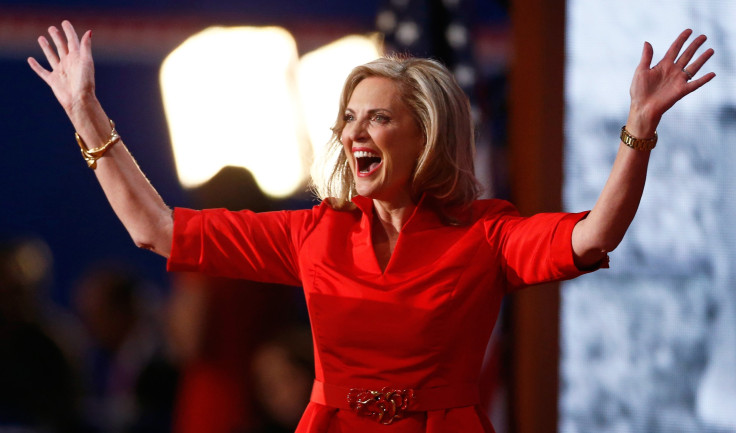Fashion Politics: Do Browne, Karan And Other Designers Favor Michelle Obama Over Ann Romney?

After the last presidential debate on Tuesday night, Thom Browne didn’t focus on the political fallout of the encounter between Barack Obama and Mitt Romney. The New York designer tweeted instead that he was humbled to see First Lady Michelle Obama wearing one of his dresses – the same design, as it happened, she had worn to the Democratic National Convention in September. Ann Romney was also sporting a designer dress, by Oscar de la Renta, but the designer’s people, led by “OscarPRGirl” Erika Bearman, uttered nary a peep about the Republican candidate’s wife wearing her third ODLR dress. Similarly, when Romney wore de la Renta -- who has famously never designed for the FLOTUS -- to the Republican National Convention, the fashion house stayed mum. The only public figure to make a mention of it was, of all people, New York City Mayor Michael Bloomberg, at the Couture Council Award Luncheon.
Snubbing Ann Romney seems to have become a trend in the fashion community. Go to the website of any top fashion magazine – Vogue, Elle, Harper’s Bazaar, W, Vanity Fair – and search for “Ann Romney;" you’ll see mentions of her are far, far fewer than stories referencing Michelle Obama’s lengthy fashion credits and critiques.
Further proof comes from two incidents in which Romney was slighted by the people who had made the clothes she was wearing. First, a spokesperson for Reed Krakoff, a designer she frequently wears, spoke out about the $990 silk shirt that caused a ruckus after she wore it during an interview with CBS in May.
"We had nothing to do with it," the rep told ABC News. "She must have bought it from Saks or Bergdorf's, we definitely didn't send it to her."
Then a spokesperson for Diane von Furstenberg, the designer and outspoken liberal who also happens to run the Council of Fashion Designers of America, told BuzzFeed Shift the company wasn’t “quite sure how Ann obtained” the DVF dress she wore to a rally in Florida in July.
This could hardly be due to Romney making poor wardrobe choices, unless you consider a de la Renta to be the equivalent of a potato sack. Meanwhile, Michelle Obama gets all the fashion cachet, having worn in public more than 50 American designers in the course of her husband’s first term.
According to Marcia Flicker, associate professor of marketing at Fordham University, Obama may just be more popular with the designers: “My perception is that Michelle Obama takes more chances in her fashion choices than does Ann Romney, who tends to wear more conservative designs.”
Or could it be that fashion is so entangled with politics that designers can’t be sartorially bipartisan? Are they all in bed with the Democrats?
Or maybe it’s because of something far simpler, that moves the world of fashion no less than it moves politics. Maybe Michelle Obama helps designers sell more clothes than Romney does. “Some of Obama's choices work very well and highlight American designers or more affordable fashion that most women can afford,” said Flicker.
Money…
There’s no argument that Obama’s influence is so powerful that when the First Lady wears an outfit, or even a nail polish color like Artistic Nail Design’s blue-grey color, it goes flying off the figurative shelves.
It all began when Obama famously wore head-to-toe J.Crew on “The Tonight Show” for her first appearance as the First Lady on late night television in 2008. Right after she uttered the words, "Actually, this is a J. Crew ensemble. You can get some good stuff online,” the J.Crew website literally crashed, and the company’s shares spiked in price. J.Crew’s creative director Jenna Lyons called Mrs. Obama “the most incredible gift that keeps on giving.” The same happened with an $148 Donna Ricco dress, which sold out across the country after Obama wore it on “The View” in June 2008.
Obama has a revenue-generating effect that, according to the Harvard Business Review, “created $2.7 billion in cumulative abnormal returns” – or in simpler words, sales that would not have occurred had she not worn an outfit – just between November 2008 and December 2009. The FLOTUS, also credited with kick-starting the careers of designers like Jason Wu and Thakoon Panichgul just by showing up in their creations, lands a company $14 million on average every time she dons an ensemble, according to the same study. And “normal” celebrities must be paid by a brand to endorse it, whereas Obama is the ideal free publicity.
And for an extra $14 million, any designer would be ready to break the old diffidence the industry used to show towards politics. “Once upon a time, fashion and lifestyle companies and their CEOs weren’t expected to publicly participate in politics,” Katie J.M. Baker wrote for Jezebel. “But now, brands have realized that they can sell more stuff — and appear appealingly hip — if they back the right candidate.”
…And Politics…
That distance between fashion and politics is ancient history now. The Washington Post’s Katherine Boyle reported back in June that, according to Federal Election Commission filings, about 50 percent of designers that Michelle Obama has worn have donated to one or both of her husband’s campaigns at some point. While many designers have always placed their financial backing on Obama, some donated only after Obama donned their creations. Boyle noted that this chain of “deep-pocketed assistance” has caused the number of designers who donated to the Obama campaign to triple as of this year.
The fashion industry doesn’t just give to Obama, of course. But the other guy gets a much smaller share of its money. According to a study from the nonpartisan Center for Responsive Politics, of the $435,160 given from the industry to the candidates this election cycle, 53.9 percent went to Obama and 45.9 percent to Republicans.
Besides the cold hard numbers, there may be attitudes that factor in as well. Donna Karan was asked during a September Couture Council luncheon whether she would dress First Lady Ann Romney, if her husband won the election.
"I can't imagine we wouldn't, but who says she's going to win?" Karan told The Cut, which noted the designer’s change of tone from a previous question about Michelle Obama.
Chief executive of Council of Fashion Designers of America Stephen Kolb told The Washington Post that designers do draw from their personal beliefs, like Prabal Gurung, who declared support for Obama after his endorsement of same-sex marriage.
At least one designer, though, has come out as a Romney supporter: Alfred Fiandaca, who told WWD that the wife of the former Massachusetts governor has been “a customer for a long time” even though he had not known it: “It wasn’t until the campaign began that I found out she had been shopping there for many, many years,” Fiandaca said. “I haven’t made anything custom for her and, honestly, I think she prefers that. If she did ask me, I would willingly and gladly, though.”
Yet, days before the WWD interview, Fiandaca’s rep told The Cut on Oct. 4 he is “apolitical” and highlighted that he has dressed both Democrats and Republicans. Then, the designer told The New York Times on Oct. 12 he doesn’t “want to sound political” but has “been a Democrat all my life.”
Perhaps the designer, who said he’s “just not very good with the limelight,” wanted to recede out of the spotlight. Or had a change of heart. But could it have been that his sudden sort-of-retraction was dictated by none other than the God of Fashion, and confirmed Democrat, Anna Wintour?
…And A Powerful High Priestess
That’s the fanatical theory that appeared after an article on Fashionista citing a possible reason for the Ann Romney snub from many designers: they fear displeasing Anna Wintour. The editor in chief of American Vogue has been portrayed in the media as a high priestess who reigns supreme, with an influence so heavy that designers have even changed their collections at the last minute before a runway show, based on her first-look critiques.
“Perhaps some designers are fearful of pissing off another powerful woman: Anna Wintour,” wrote Hayley Phelan. “Wintour is one of Obama’s top bundlers–and one of his most vocal supporters, appearing in commercials to aid his re-election campaign…Could Wintour’s evident support for Obama be discouraging designers from working with Ann?”
After all, fashion’s involvement in politics has even evolved into an official Democratic-focused campaign called Runway to Win, along with multiple charity benefits for the Obama campaign, for which Wintour herself has raised an amount exceeding $500,000, according to Obama’s public list of volunteer fundraisers.
“Wintour’s connections and influence in Hollywood, fashion, and society aren’t merely pretty, shiny things to have around; they have become vital to the financial success of the campaign,” wrote Noreen Malone in the November edition of The New Republic. “She is in search of something more than a victory in November; she wants politics to take fashion seriously.”
But it may not be necessary to cook up conspiracy theories involving a powerful editrix to explain why the Obamas and the designers who dress the First Lady are big friends. It may just boil down to the simple fact that they both benefit from the relationship.
“Clearly, both the administration, and by extension the First Lady, made a decision that they would be public in their support for fashion — so, we’re in. We want to support them,” said Simon Collins, the dean of fashion at Parsons the New School for Design, to The Washington Post. “For those who say it’s just Michelle, frankly, it trivializes the attention the administration is paying to our industry.”
© Copyright IBTimes 2024. All rights reserved.






















